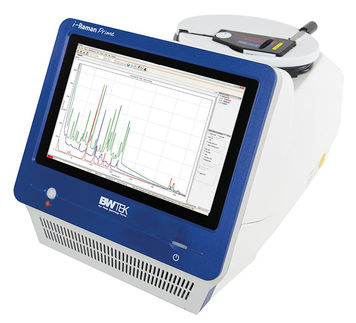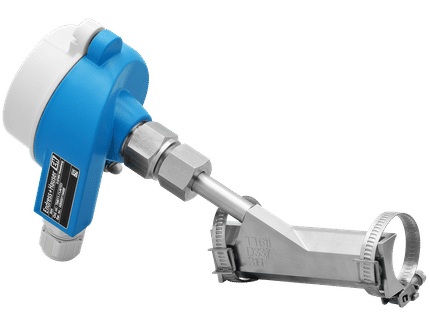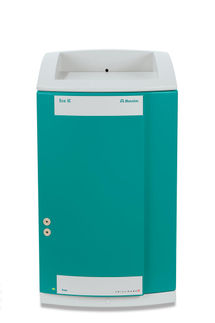The GABA receptors are a class of receptors that respond to the neurotransmitter γ-aminobutyric acid (GABA), the chief inhibitory neurotransmitter in the vertebrate central nervous system. There are three classes of GABA receptors: GABAA, GABAB, and GABAС.
GABAA and GABAС receptors are ligand-gated ion channels (also known as ionotropic receptors), whereas GABAB receptors are G protein-coupled receptors (also known as metabotropic receptors).
Ligand-gated ion channels
GABAA
It has long been recognized that the fast response of neurons to GABA that is blocked by bicuculline and picrotoxin is due to direct activation of an anion channel.[1][2][3][4][5]
This channel was subsequently termed the GABAA receptor.[1] Fast-responding GABA receptors are members of family of Cys-loop ligand-gated ion channels.[6][7][8] Members of this superfamily, which includes nicotinic acetylcholine receptors, GABAA and GABAС receptors, glycine and 5-HT3 receptors, possess a characteristic loop formed by a disulphide bond between two cysteine residues.
GABAС
A second type of ionotropic GABA receptors, insensitive to typical allosteric modulators of GABAA receptor channels such as benzodiazepines and barbiturates,[9][10][11] was designated GABAС receptor.[12][13]
Native responses of the GABAС receptor type occur in retinal bipolar or horizontal cells across vertebrate species.[14][15][16][17] GABAС receptors are exclusively composed of ρ subunits that are related to GABAA receptor subunits.[18][19][20]
Although the term "GABAС receptor" is frequently used, GABAС may be viewed as a variant within the GABAA receptor family.[6] However others have argued that the differences between GABAС and GABAA receptors are large enough to justify maintaining the distinction between these two subclasses of GABA receptors.[21]
Common characteristics
In ionotropic GABAA and GABAС receptors, binding of GABA molecules to their binding sites in the extracellular part of receptor triggers opening of a chloride ion-selective pore.
Opening of a chloride conductance drives the membrane potential towards the reversal potential of the Cl¯ ion which is about –80 mV in neurons, inhibiting the firing of new action potentials.
However, there are numerous reports on GABAA receptors, which are actually excitatory. This phenomenon is due to increased intracellular concentration of Cl¯ ions either during development of the nervous system[22][23] or in certain cell populations.[24][25][26]
After this period of development, a Chloride pump is upregulated and inserted into the cell membrane, pumping Cl- ions into the extracellular space of the cell. Further openings via GABA binding to the receptor then produce inhibitory responses. Over-excitation of this receptor induces receptor remodeling and the eventual invagination of the GABA receptor. As a result, further GABA binding becomes inhibited and IPSPs are no longer relevant.
G protein coupled receptor: GABAB
A slow response to GABA is mediated by GABAB receptors,[27] originally defined on the basis of pharmacological properties.[28]
In studies focused on the control of neurotransmitter release, it was noted that a GABA receptor was responsible for modulating evoked release in a variety of isolated tissue preparations. This ability of GABA to inhibit neurotransmitter release from these preparations was not blocked by bicuculline, was not mimicked by isoguvacine, and was not dependent on Cl¯, all of which are characteristic of the GABAA receptor. The most striking discovery was the finding that baclofen (β-parachlorophenyl GABA), a clinically employed spasmolytic[29][30] mimicked, in a stereoselective manner, the effect of GABA.
Later ligand-binding studies provided direct evidence of binding sites for baclofen on central neuronal membranes.[31] cDNA cloning confirmed that the GABAB receptor belongs to the family of G-protein coupled receptors.[32] Additional information on GABAB receptors has been reviewed elsewhere.[33][34][35][36][37][38][39][40]
Summary
Thus, GABAA and GABAС receptors are ligand-gated ion channels, whereas GABAB receptors are G protein-coupled receptors.
This has a parallel to several other systems in the body, where a single molecule binds to receptors which function in completely different ways:
References
- ^ a b Kuffler SW, Edwards C (1958). "Mechanism of gamma-aminobutyric acid (GABA) action and its relation to synaptic inhibition". J Neurophysiol 21 (6): 589–610. PMID 13599049.
- ^ Kravitz EA (1963). "Gamma-aminobutyric acid and other blocking compounds in crustacea. III. Their relative concentrations in separated motor and inhibitory axons". J Neurophysiol 26: 739–751. PMID 14065325.
- ^ Krnjevic K, Schwartz S (1967). "The action of γ-aminobutyric acid on cortical neurones". Expl Brain Res 3: 320–336. PMID 6031164.
- ^ Takeuchi A, Takeuchi N (1967). "Anion permeability of the inhibitory post-synaptic membrane of the crayfish neuromuscular junction". J Physiol 191: 575–590. PMID 6051794. Full text at PMC: 1365493.
- ^ Takeuchi A, Takeuchi N (1969). "A study of the action of picrotoxin on the inhibitory neuromuscular junction of the crayfish". J Physiol 205: 377–391. PMID 5357245. Full text at PMC: 1348609.
- ^ a b Barnard EA et al. (1998). "International Union of Pharmacology. XV. Subtypes of gamma-aminobutyric acidA Receptors: Classification on the Basis of Subunit Structure and Receptor Function". Pharmacol Rev 50 (2): 291–314. PMID 9647870. Free full text
- ^ Hevers W, Luddens H (1998). "The diversity of GABAA receptors. Pharmacological and electrophysiological properties of GABAA channel subtypes". Mol Neurobiol 18 (1): 35–86. PMID 9824848
- ^ Sieghart W, Sperk G (2002). "Subunit composition, distribution and function of GABAA receptor subtypes". Curr Top Med Chem 2 (8): 795–816. PMID 12171572.
- ^ Sivilotti L, Nistri A (1991). "GABA receptor mechanisms in the central nervous system". Prog Neurobiol 36 (1): 35–92. PMID 1847747.
- ^ Bormann J, Feigenspan A (1995). "GABAC receptors". Trends Neurosci 18 (2): 515–519. PMID 8638289.
- ^ Johnston, GR (1996). "GABAC receptors: relatively simple transmitter-gated ion channels?" Trends Pharmacol Sci 17 (9): 319–323. PMID 8885697.
- ^ Drew CA, Johnston GR, Weatherby RP (1984). "Bicuculline-insensitive GABA receptors: Studies on the binding of (β)-baclofen to rat cerebellar membranes". Neurosci Lett 52 (3): 317–321. PMID 6097844.
- ^ Zhang D, Pan ZH, Awobuluyi M, Lipton SA (2001). "Structure and function of GABAC receptors: a comparison of native versus recombinant receptors". Trends Pharmacol Sci 22 (3): 121–132. PMID 11239575.
- ^ Feigenspan A, Wassle H, Bormann J (1993). "Pharmacology of the GABA receptor C1─ channel in rat retina bipolar cells". Nature 361 (6408): 159–162. PMID 7678450.
- ^ Quian H, Dowling JE (1993). "Novel GABA responses from rod-driven retinal horizontal cells". Nature 361 (6408): 162–164. PMID 8421521.
- ^ Lukasiewicz PD (1996). "GABAC receptors in the vertebrate retina". Mol Neurobiol 12 (3): 181–194. PMID 8884747.
- ^ Wegelius K et al. (1998). "Distribution of GABA receptor rho subunit transcripts in the rat brain". Eur J Neurosci 10 (1): 350–357. PMID 9753143.
- ^ Shimada S, Cutting GR, Uhl GR (1992). "γ-Aminobutyric acid A or C receptor? γ-aminobutyric acid ρ1 receptor RNA induces bicuculline-, barbiturate-, and benzodiazepine-insensitive γ-aminobutyric acid responses in Xenopus oocytes". Mol Pharmacol 41 (4): 683–687. PMID 1314944.
- ^ Kusama T et al. (1993). "Pharmacology of GABAρ1 and GABAα/β receptors expressed in Xenopus oocytes and Cos cells". Br J Pharmacol 109 (1): 200–206. PMID 8388298.
- ^ Kusama T, Wang TL, Guggino WB, Cutting GR, Uhl GR (1993). "GABA rho2 receptor pharmacological profile: GABA recognition site similarities to rho1". Eur J Pharmacol 245 (1): 83–84. PMID 8386671.
- ^ Chebib M, Johnston GA (2000). "GABA-Activated ligand gated ion channels: medicinal chemistry and molecular biology.". J Med Chem 43 (8): 1427-47. PMID 10780899.
- ^ Ben-Ari Y, Khazipov R, Leinekugel X, Caillard O, Galarsa, J-L (1997). "GABAA, NMDA and AMPA receptors: A developmentally regulated 'menage a trois'." Trends Neurosci 20 (11): 523–529. PMID 9364667.
- ^ Taketo M, Yoshioka T (2000). "Developmental change of GABAA receptor-mediated current in rat hippocampus". Neuroscience 96: 507–514.
- ^ Tomiko SA, Taraskevich PS, Douglas WW (1983). "GABA acts directly on cells of pituitary pars intermedia". Nature 301 (5902): 706–707. PMID 6828152.
- ^ Cherubini E, Giairsa JL, Ben-Ari Y (1991). "GABA, an excitatory transmitter in early postnatal life". Trends Neurosci 14 (12): 515–519. PMID 1726341.
- ^ Lamsa K, Taira T (2003). "Use-dependent shift from inhibitory to excitatory GABAA receptor action in SP-O interneurons in the rat hippocampal CA3 area". J Neurophysiol 90 (3): 1983–1995. PMID 12750426. Free full text
- ^ Bowery NG et al. (2002). "International Union of Pharmacology. XXXIII. Mammalian γ-Aminobutyric AcidB Receptors: Structure and Function". Pharmacol Rev 54 (2): 247–264. PMID 12037141. Free full text
- ^ Bowery NG et al. (1980). "(β)-Baclofen decreases neurotransmitter release in the mammalian CNS by an action at a novel GABA receptor". Nature 283 (5742): 92–94. PMID 6243177.
- ^ Bein HJ (1972). "Pharmacological differentiations of muscle relaxants". In: Birkmayer W (ed.) Spasticity: A Topical Survey, pp. 76–89. Vienna: Hans Huber.
- ^ Keberle H, and Faigle JW (1972) "Synthesis and structure-activity relationship of the gamma-aminobutyric acid derivatives". In: Birkmayer W (ed.) Spasticity: A Topical Survey, pp. 76–89. Vienna: Hans Huber.
- ^ Hill DR, Bowery NG (1981). "[3H]-baclofen and [3H]-GABA bind to bicuculline insensitive GABAB sites in rat brain". Nature 290 (5802): 149–152. PMID 6259535.
- ^ Kaupmann K et al. (1997). "Expression cloning of GABAB receptors uncovers similarity to metabotropic glutamate receptors". Nature 386 (6622): 239–246. PMID 9069281.
- ^ Enna SJ (1997). "GABAB receptor agonists and antagonists: pharmacological properties and therapeutic possibilities". Expert Opin Investig Drugs 6 (10): 1319–1325. PMID 15989503.
- ^ Enna SJ, Bowery NG (1997). In: The GABA Receptors, 2nd ed. Totowa, NJ: Humana Press.
- ^ Kaupmann K et al. (1998). "GABAB-receptor subtypes assemble into functional heteromeric complexes". Nature 396 (6712): 683–687. PMID 9872317.
- ^ Kaupmann K et al. (1998). "Human gamma-aminobutyric acid type B receptors are differentially expressed and regulate inwardly rectifying K+ channels". Proc Natl Acad Sci USA 95 (25): 14991–14996. PMID 9844003. Full text at PMC: 24563.
- ^ Marshall FH, Jones KA, Kaupmann K, Bettler B (1999). "GABAB receptors−the first 7TM heterodimers". Trends Pharmacol Sci 20 (10): 396–399. PMID 10498952.
- ^ Marshall FH, White J, Main M, Green A, Wise A (1999). "GABAB receptors function as heterodimers". Biochem Soc Trans 27 (4): 530–535. PMID 10917635.
- ^ Bowery NG, Enna SJ (2000). "gamma-aminobutyric acid(B) receptors: first of the functional metabotropic heterodimers". J Pharmacol Exp Ther 292 (1): 2–7. PMID 10604925. Erratum in J Pharmacol Exp Ther 293 (1): 313.
- ^ Enna SJ (2000). "GABAB receptor signaling pathways". In: Mohler H (ed.) Pharmacology of GABA and Glycine Neurotransmission, pp. 329–342. Berlin: Springer-Verlag. ISBN 3540676163
| Transmembrane receptor: G protein-coupled receptors |
|---|
| Class A: Rhodopsin like | Acetylcholine (M1, M2, M3, M4, M5) - Adrenergic (α1 (A, B, D), α2 (A, B, C), β1, β2, β3) - Adrenomedullin - Anaphylatoxin (C3a, C5a) - Angiotensin (1, 2) - Apelin - Bile acid - Bombesin (BRS3, GRPR, NMBR) - Bradykinin (B1, B2) - Cannabinoid (CB1, CB2) - Chemokine - Cholecystokinin (A, B) - Dopamine (D1, D2, D3, D4, D5) - Eicosanoid (CysLT (1, 2), LTB4 (1, 2), FPRL1, OXE, Prostaglandin ((DP (1, 2), EP (1, 2, 3, 4), PGF, Prostacyclin, Thromboxane) - EBI2 - Endothelin (A, B) - Estrogen - Formyl peptide (1, L1, L2) - Free fatty acid (1, 2, 3, 4) - FSH - Galanin (1, 2, 3) - Gonadotropin-releasing hormone (1, 2) - GPR (1, 3, 4, 6, 12, 15, 17, 18, 19, 20, 21, 22, 23, 25, 26, 27, 31, 32, 33, 34, 35, 37, 39, 42, 44, 45, 50, 52, 55, 61, 62, 63, 65, 68, 75, 77, 78, 79, 82, 83, 84, 85, 87, 88, 92, 101, 103, 119, 120, 132, 135, 139, 141, 142, 146, 148, 149, 150, 151, 152, 153, 160, 161, 162, 171, 172, 173, 174, 176, 182) - Ghrelin - Histamine (H1, H2, H3, H4) - Kisspeptin - Luteinizing hormone/choriogonadotropin - Lysophospholipid (1, 2, 3, 4, 5, 6, 7, 8) - MAS (1, 1L, D, E, F, G, X1, X2, X3, X4) - Melanocortin (1, 2, 3, 4, 5) - MCHR (1, 2) - Melatonin (1A, 1B)- Motilin - neuromedin (B, U (1, 2)) - Neuropeptide (B/W (1, 2), FF (1, 2), S, Y (1, 2, 4, 5)) - Neurotensin (1, 2) - Opioid (Delta, Kappa, Mu, Nociceptin, but not Sigma) - Olfactory - Opsin (3, 4, 5, 1LW, 1MW, 1SW, RGR, RRH) - Orexin (1, 2) - Oxytocin - Oxoglutarate - PAF - Prokineticin (1, 2) - Prolactin-releasing peptide - Protease-activated (1, 2, 3, 4) - Purinergics (Adenosine (A1, A2a, A2b, A3), P2Y, (1, 2, 4, 5, 6, 8, 9, 10, 11, 12, 13, 14)) - Relaxin (1, 2, 3, 4) - Somatostatin (1, 2, 3, 4, 5) - Serotonin, all but 5-HT3 (5-HT1 (A, B, D, E, F), 5-HT2 (A, B, C), 5-HT (4, 5A, 6, 7)) - SREB - Succinate - TAAR (1, 2, 3, 5, 6, 8, 9) - Tachykinin (1, 2, 3) - Thyrotropin - Thyrotropin-releasing hormone - Urotensin-II - Vasopressin (1A, 1B, 2) |
|---|
| Class B: Secretin like | Brain-specific angiogenesis inhibitor (1, 2, 3) - Cadherin (1, 2, 3) - Calcitonin - CD97 - Corticotropin-releasing hormone (1, 2) - EMR (1, 2, 3) - Glucagon (GR, GIPR, GLP1R, GLP2R) - Growth hormone releasing hormone - PACAPR1- GPR (56, 64, 97, 98, 110, 111, 112, 113, 114, 115, 116, 123, 124, 125, 126, 128, 133, 143, 144, 157) - Latrophilin (1, 2, 3, ELTD1) - Parathyroid hormone (1, 2) - Secretin - Vasoactive intestinal peptide (1, 2) |
|---|
| Class C: Metabotropic glutamate / pheromone | Calcium-sensing receptor - GABA B (1, 2) - Glutamate receptor (Metabotropic glutamate (1, 2, 3, 4, 5, 6, 7, 8)) - GPRC6A - GPR (156, 158, 179) - RAIG (1, 2, 3, 4) - Taste receptors (TAS1R (1, 2, 3) TAS2R (1, 3, 4, 5, 8, 9, 10, 12, 13, 14, 16, 38, 39, 40, 41, 43, 44, 45, 46, 47, 48, 49, 50)) |
|---|
| Frizzled / Smoothened | Frizzled (1, 2, 3, 4, 5, 6, 7, 8, 9, 10) - Smoothened |
|---|
| Ion channel, receptor: ligand-gated ion channels |
|---|
| Cys-loop receptors | 5-HT receptor (5-HT3 serotonin receptor (A)) - GABA receptor (GABA A (α1, α2, α3, α5, α6, β1, β2, β3, γ2, ε), GABA C (ρ1)) - Glycine receptor (α1) - Nicotinic acetylcholine receptor (α1, α2, α3, α4, α5, α7, β2, β3, β4, δ, ε, (α4)2(β2)3, (α7)5, Ganglion type, Muscle type) |
|---|
| Ionotropic glutamate receptors | AMPA (1, 2, 3, 4) - Kainate (1, 2) - NMDA (1, 2A, 2B, 2C, 2D) |
|---|
| ATP-gated channels | Purinergic receptors (P2X (1, 4, 5, 7)) |
|---|
|







